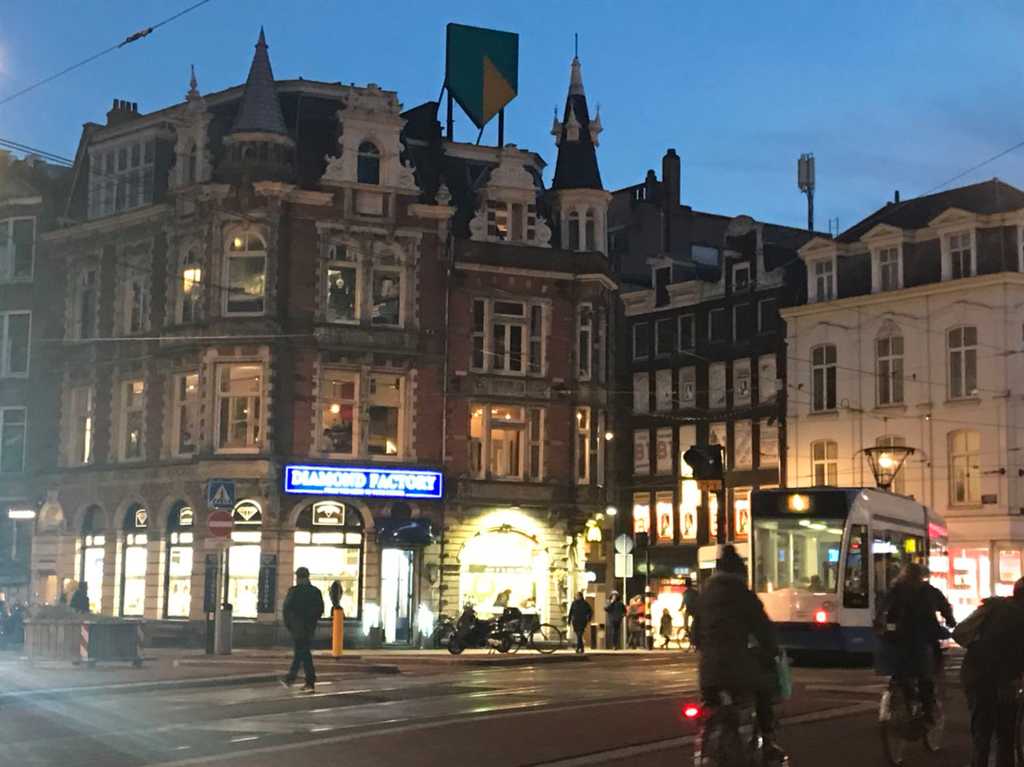Places to visit in Amsterdam
Amsterdam Central Station- Rembrandt Square

Wikipedia:
Amsterdam Centraal was designed by Dutch architect Pierre Cuypers and first opened in 1889. It features a Gothic/Renaissance Revival station building and a cast iron platform roof spanning approximately 40 metres.

The Beursplein is a square in the center of Amsterdam, between the Damrak and the Beursstraat. On the square are the Stock Exchange ('Beursplein 5'), the Beurs van Berlage and the Bijenkorf. Opposite the Beursplein, the Beurspassage connects the Damrak with the Nieuwendijk.

Wikipedia: The Beurs van Berlage was designed as a commodity exchange by architect Hendrik Petrus Berlage and constructed between 1896 and 1903. It influenced many modernist architects, in particular functionalists and the Amsterdam School. It is now used as a venue for concerts, exhibitions, and conferences. There is Damrak street on the east facade of the building. This is the rak (reach), a straight part of the Amstel river near a dam; hence the name.

Wikipedia:
The Dam derives its name from its original function: a dam on the Amstel River, hence also the name of the city.[1] Built in approximately 1270, the dam formed the first connection between the settlements on the sides of the river.
As the dam was gradually built up to it became wide enough for a town square, which remained the core of the town developing around it. Dam Square as it exists today grew out of what was originally two squares: the actual dam, called Middeldam; and Plaetse, an adjacent plaza to the west. A large fish market arose where ships moored at the dam to load and unload goods. The area became a centre not only of commercial activity but also of the government, as the site of Amsterdam's town hall.
As a market square, the Dam had a weigh house that can be seen in some old paintings. It was demolished in 1808 by order of Louis Bonaparte who, upon taking up residence in the newly converted Royal Palace, complained that his view was obstructed.
The Damrak, or the former mouth of the Amstel River, was partially filled in the 19th century; since then, the Dam square has been surrounded by land on all sides. The new land made room for the Beurs van Zocher, a stock exchange that was built in 1837. After the stock trade moved to the Beurs van Berlage in 1903, the Zocher building was demolished. In its place, De Bijenkorf department store has stood since 1914.
In 1856, a war memorial named De Eendracht (The Unity) was unveiled inside the square before King William III. A stone column with a female statue on top, the monument acquired the nickname "Naatje of the Dam". It was taken down in 1914.

Wikipedia: The Rokin is a canal and major street in Amsterdam, Netherlands located in the Centrum borough and Binnenstad neighbourhood. Originally it was part of the river Amstel, and was known then as Ruck-in (from 'inrukken', which means 'to withdraw', as some of the houses on the Amstel had to be shortened to construct the quays there in the 16th century).

On the another bank we can see the remarkable building. This is the Amsterdam Allard Pierson museum. From Wikipedia: The name of the Allard Pierson Museum derives from the first professor of classical archaeology at the University of Amsterdam, Allard Pierson (1831–1896). This former clergyman was invited in 1877 to occupy the chair of Aesthetics, Art History, and Modern Languages at the newly founded university. His passion for antiquity, fuelled by his travels to the Mediterranean area, led to his assembling a collection of plaster casts from 1877 to 1895.

Wikipedia: The Munttoren ("Mint Tower") or Munt is a tower in Amsterdam, the Netherlands. It stands on the busy Muntplein square, where the Amstel river and the Singel canal meet, near the flower market and the eastern end of the Kalverstraat shopping street. The tower was originally part of the Regulierspoort, one of the main gates in Amsterdam's medieval city wall. The gate, built in the years 1480,[1] consisted of two towers and a guard house. Just after the renovation around 1961, cinema organist played weekly on the Munt bells and even made a recording of the bells together with the City Theater orchestra directed by Lex van Weren. This EP, titled It's in the air, was released by Phillips Records. Scale models of the tower are exhibited at Madurodam in The Hague and at Mini-Europe in Brussels.

Wikipedia:
Pathé Tuschinski, originally Theater Tuschinski, is a movie theater in the Netherlands in Amsterdam commissioned by Abraham Icek Tuschinski in 1921 at a cost of 4 million guilders. The interior and exterior are a spectacular mix of styles, as designed by Hijman Louis de Jong; Amsterdam School, Art Nouveau and Art Deco. The main auditorium hosts many premieres of Dutch films. It is considered to be one of the most beautiful cinemas in the world.



